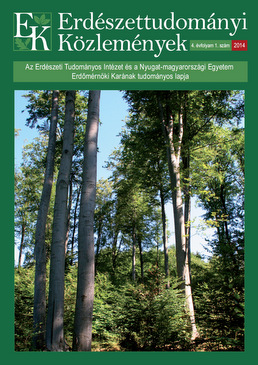| 1. | Baloghné B.Zs.; Tóth J.; Koncz Cs.; Molnár A. és Gencsi Z. 2000: Különböző erdőfelújítási módok hatása észak-alföldi gyertyános-kocsányos tölgyes gyepszintjére, talajfaunájára és talajlakó mikroorganizmusaira. Erdészeti Lapok, 135 (5): 142-145. full text |
| 2. | Barber, H.S. 1931: Traps for cave-inhabiting insects. Journal of the Elisha Mitchell Scientific Society, 46: 259-266. |
| 3. | Bray, J.R. and Curtis, J.T. 1957: An ordination of the upland forest communities of Southern Wisconsin. Ecological Monographs, 27: 325-349. DOI: 10.2307/1942268 |
| 4. | Erwin, T.L. 1985: The taxon pulse: a general pattern of lineage radiation and extinction among carabid beetles. 437-472. In: Ball G.E. (ed.): Taxonomy, Phylogeny and Zoogeography of Beetles and Ants Junk, The Hague. |
| 5. | Halász G. (szerk.) 2006: Magyarország erdészeti tájai. Állami Erdészeti Szolgálat, Budapest. |
| 6. | Hůrka, K. 1996: Carabidae of the Czech and Slovak Republic. Kabourek, Zlín. |
| 7. | Kádár F. és Samu F. 2006: A duplaedényes talajcsapdák használata Magyarországon. Növényvédelem, 42 (6): 305-312. |
| 8. | Kollár T. 2013: Lékek fényviszonyainak vizsgálata hemiszférikus fényképek segítségével. Erdészettudományi Közlemények, 3(1): 71-78. full text |
| 9. | Koloszár J. 2010: Erdőneveléstan. Egyetemi jegyzet, NYME, Sopron. |
| 10. | Koivula, M. and Niemelä J. 2003: Gap felling as a forest harvesting method in boreal forests-responses of carabid beetles (Coleoptera, Carabidae). Ecography, 26: 179-187. DOI: 10.1034/j.1600-0587.2003.03340.x |
| 11. | Krebs, C.J. 1978: Ecology: The Experimental Analysis of Distribution and Abundance. 6th ed. Benjamin Cummings, San Francisco, USA |
| 12. | Kutasi Cs. 2000: Futóbogarak (Col.: Carabidae) a Pannonhalmi Tájvédelmi Körzetből. Folia Musei Historico-Naturalis Bakonyiensis, 15 („1996”): 93-100. |
| 13. | Kutasi Cs. 2001: Futóbogarak (Col.: Carabidae) vizsgálata a veszprémi Csatár-hegyen és környékén. Folia Musei Historico-Naturalis Bakonyiensis, 18 („1999”): 95-104. |
| 14. | Kutasi Cs. 2009: A Bakony futóbogár fajainak (Coleoptera: Carabidae) listája. Folia Musei Historico-Naturalis Bakonyiensis, 26: 21-32. |
| 15. | Kutasi Cs. 2011: Védett és ritka bogárfajok (Coleoptera) a Várpalotai lőtér területéről. Folia Musei Historico-Naturalis Bakonyiensis, 28: 201-216. |
| 16. | Lövei G. 2008: Futóbogarak (Coleoptera: Carabidae) ökológiai és természetvédelmi vizsgálata növekvő antropogén hatás időszakában. Akadémiai doktori értekezés összefoglalója. Budapest. |
| 17. | Lövei, G.L. and Sunderland, K.D. 1996: Ecology and behavior of ground beetles (Coleoptera: Carabidae). Annual Review of Entomology, 41: 231-256. DOI: 10.1146/annurev.en.41.010196.001311 |
| 18. | Magura T. 2011: Az urbanizáció hatása a talajfelszíni ízeltlábúakra, különös tekintettel a futóbogarakra (Coleoptera: Carabidae). MTA Doktori Pályázat, Doktori értekezés, Debrecen. |
| 19. | Magura T. 2013: Az urbanizáció hatása a talajfelszíni ízeltlábúakra. Az erdei specialisták hanyatlása. Élet és Tudomány, 2013/44, 1395-1397. |
| 20. | Merkl O. és Kovács T. 1997: Nemzeti Biodiverzitás-monitorozó Rendszer VI. Bogarak. Magyar Természettudományi Múzeum, Budapest. |
| 21. | Merkl O. és Vig K. 2009: Bogarak a Pannon Régióban. Vas Megyei Múzeumok Igazgatósága, B. K. L. Kiadó és a Magyar Természettudományi Múzeum, Szombathely. |
| 22. | Müller-Motzfeld, G. (ed.) 2004: Band 2. Adephaga 1: Carabidae (Laufkäfer). 2. Auflage. In: Freude, H., Harde, K.W., Lohse, G.A. und Klausnitzer, B. (eds.): Die Käfer Mitteleuropas. Elsevier GMBH, Spektrum Akademischer Verlag, Heidelberg Berlin. |
| 23. | Nagy F.; Szél Gy. és Vig K. 2004: Vas megye futóbogár faunája (Coleoptera: Carabidae). Praenorica, Folia historiconaturalia, 7: 1-235. |
| 24. | Papp J. 1968: A Bakony-hegység állatföldrajzi viszonyai. A Veszprém Megyei Múzeumok Közleményei, 7: 251-314. |
| 25. | Pielou, E.C. 1966: The measurement of diversity in different types of biological collection. Journal of Theoretical Biology, 13: 131-144. |
| 26. | Schwerdtfeger, F. 1977: Ökologie der Tiere. Ein Lehrbuch in drei Teilen. Band I. Autökologie. Die Beziehungen zwischen Tier und Umwelt. Verlag Paul Parey, Hamburg und Berlin. |
| 27. | Shannon, C.E. and Weaver, W. 1949: The Mathematical Theory of Communication. University of Illionis Press, Urbana. |
| 28. | Siffer S. 2012: Szálalás száraz tölgyesekben. 121-133. In: Gyöngyössy P. (szerk.): Múlt és jövő IV. Tartamosság, természetszerűség, társadalmi kontroll. Nyugat-magyarországi Egyetem Kiadó, Sopron. |
| 29. | Solymos R. 2000: Erdőfelújítás és -nevelés a természetközeli erdőgazdálkodásban. Mezgazdasági Szaktudás Kiadó. Budapest. |
| 30. | Szél Gy. 2011: Futóbogár-együttesek vizsgálata a Lajta-project (Mosonszolnok) területén. Doktori (PhD) értekezés. Nyugat-magyarországi Egyetem, Sopron. full text |
| 31. | Szél Gy. és Kutasi Cs. 2003: Tihanyi élőhelyek bogárfaunisztikai vizsgálata. Folia Musei Historico-Naturalis Bakonyiensis, 20: 77-106. |
| 32. | Szél, Gy. and Kutasi, Cs. 2005: Influence of land-use intensity on the ground beetle assemblages (Coleoptera: Carabidae) in Central Hungary. 305-311. In: Lövei, G. and Toft, S. (eds.): European Carabidology 2003. Proceedings of the 11th European Carabidologist Meeting. DIAS Reports Plant Production 114. |
| 33. | Szél Gy.; Retezár I.; Bérces S.; Fülöp D.; Szabó K. és Pénzes Zs. 2007: Magyarország futrinkái. 81-106. In: Forró L.(szerk.): A Kárpát-medence állatvilágának kialakulása. Magyar Természettudományi Múzeum, Budapest. |
| 34. | Tóth J. 1999: Erdészeti rovartan. Agroinform Kiadó, Budapest. |
| 35. | Tóth L. 1973: A Bakony hegység futóbogár-alkatú faunájának alapvetése (Coleoptera: Cicindelidae et Carabidae). A Veszprém Megyei Múzeumok Közleményei, 12: 275-351. |
| 36. | Woodcock, B.A. 2005: Pitfall trapping in ecological studies. 37-57. In: Leather, S. (ed.): Insect Sampling in Forest Ecosystems. Blackwell, Oxford. DOI: 10.1002/9780470750513.ch3 |
